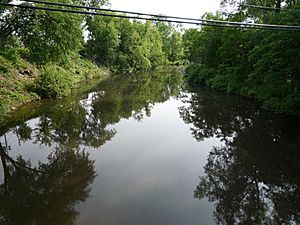Kinnickinnic River (St. Croix River tributary) facts for kids


The Kinnickinnic River, often called the Kinni, is a river in northwestern Wisconsin, United States. It is about 22-mile-long (35 km). The Kinni is known for its cold water, which is perfect for fish. It is home to native Brook Trout and Brown Trout that reproduce naturally.
Contents
River Designations
The Kinnickinnic River is very special. The Wisconsin Department of Natural Resources (WI DNR) calls it a Class I trout stream. This means it's a "high quality" trout water. It has enough natural fish reproduction to keep its wild trout populations healthy.
The Kinni is also an Outstanding Resource Water (ORW). This applies to parts of the river, both above and below the city of River Falls. This ORW title means the Kinni offers great outdoor fun. It also provides important homes for fish and wildlife. Its water quality is excellent, and human activities have not harmed it much. This designation helps protect the river from pollution.
What's in a Name?
The city of River Falls, Wisconsin is located on the Kinnickinnic River. The city was named after the historic Junction Falls waterfall on the river. The main part of the Kinnickinnic River and its South Fork meet here.
The name Kinnickinnic comes from the Ojibwe word giniginige. This word refers to a mix of tobacco and other plants used for smoking.
River History
The first European settler along the Kinnickinnic River was Judge Joel Foster. He arrived in the winter of 1848-1849. He lived in a cave where the main river and its South Fork meet. Foster wrote about the two Native American tribes in the area, the Sioux and the Chippewa. He noted that both tribes valued the St. Croix River Valley very much.
In 1849, two brothers, Nathaniel N. and Oliver Stanley Powell, also claimed land nearby. They built the first business building in River Falls in 1852. It was located right on the banks of the Kinnickinnic River. In 1854, Foster built a sawmill and a dam. This mill later grew to include a feed store. Other businesses, like a brickyard and flour mills, also started along the river.
River Geography
The Kinnickinnic River starts from springs in St. Croix County. It flows southwest and then empties into the St. Croix River at Kinnickinnic State Park.
The river changes as it flows.
- Above River Falls: The river flows slowly here. Its bottom is sandy and silty, and the river bed is narrower.
- Below River Falls: The river bed becomes wider and is mostly made of stone.
A lot of sand and silt settles where the Kinni meets the St. Croix River. This area is even called the "Kinnickinnic Narrows." The water above River Falls is also a bit colder. This temperature difference might be because of the two hydroelectric dams. These dams create shallow, still pools of water. This allows the river water to warm up before flowing downstream.
The different parts of the river also have different fish.
- Upper River: This section has many smaller trout.
- Lower River: The warmer water here supports more minnows and crustaceans. This means it can support larger trout, but there are fewer of them.
- Near the Delta: The water gets even warmer here. This part of the river is home to fish that like warmer water, like smallmouth bass.
The Kinni watershed is a beautiful area. It has scenic bluffs, rare oak savannas, and original prairies. You can also find farmlands, white pine forests, and wetlands. Its smaller creeks are cold and clean. They are important for wild native brook trout and have many springs.
River Dams
The River Falls Municipal Utility owns and runs the Powell and Junction Falls dams. These dams are part of a hydroelectric project. In February 2018, the River Falls city council decided to remove these dams. The plan is to remove the Powell Dam by 2026. The Junction Falls Dam is planned to be removed between 2035 and 2040.
River Recreation
The Kinnickinnic River offers many fun activities.
- Trout Fishing: This is the main activity on the upper parts of the river.
- Trails: Near downtown River Falls, you can walk, hike, or mountain bike on trails. These trails start in Heritage Park and cross a swinging bridge. They connect to more trails below the lower dam.
- Bird Watching: River Falls is a "Bird City," so many bird watchers visit the river.
- Kayaking: This has become popular on the lower parts of the river. Several businesses offer shuttle services for kayakers. You can launch below the lower dam and get picked up at the County F bridge near Kinnickinnic State Park. Some people also launch kayaks north of the city and take them out in Heritage Park.
Public access to the lower part of the Kinnickinnic River is limited. You can usually get to the lower river at three main spots. These are just downstream from the Glen Park dam and near the County Highway F bridge at Kinnickinnic State Park.


